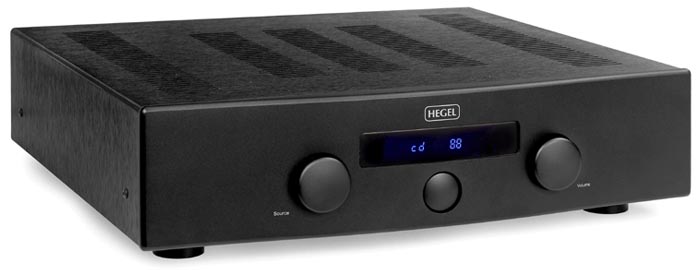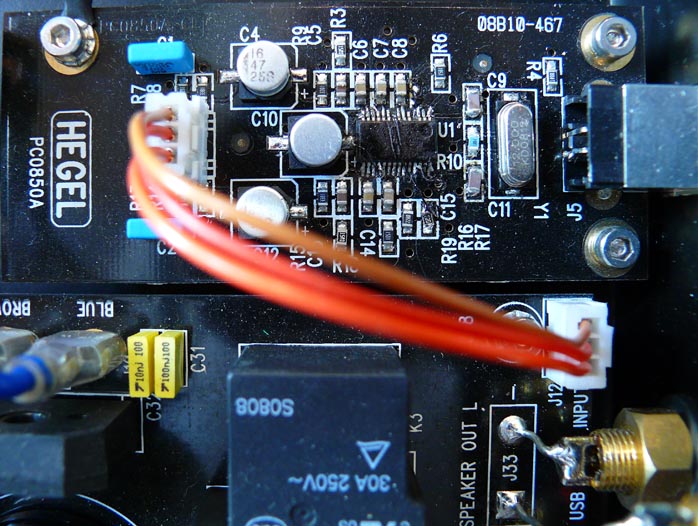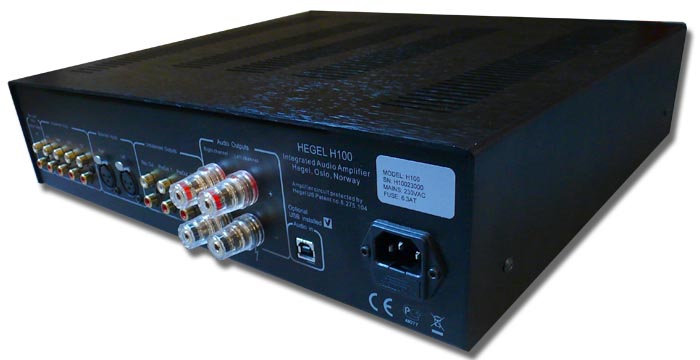This review page is supported in part by the sponsors whose ad banners are displayed below |
 |
 |
 |
The H-100 integrated further runs DualPower™ power supplies. That's more Hegel Speak for discrete and dual-mono secondaries for the input, FET voltage-gain and 8 x 15A/150W bipolar current-buffer stages. DualAmp™ refers to separating the voltage and current gain blocks into discrete stages. The stock USB sound card bypasses a computer's own. The OS of "reasonably new" Windows and Mac operating systems as well as the most common Linux platforms will automatically take control of the amplifier's sound card. Hegel believes the advantage of theirs isn't necessarily the DAC chip itself ("it only has limited importance") but the actual circuit implementation. "Ours is quieter, more dynamic and has lower distortion." For general amplifier specs, we get a S/N ratio better than 100dB, cross talk of below -100dB, a damping factor above 1000 and power supply capacitance of 67,000uF with a 630V toroid. Power consumption at idle is 30 watts, dimensions are 10 x 43 x 37cm (HxWxD), weight is 16kg. USB sound card image next.
|
|
|
 |
|
 |
For standard connectivity, the H-100 offers four variable RCA inputs and one XLR, one single-ended HT input fixed at unity gain (75 on the 99-max volume display), two variable RCA outputs and one fixed and single 5-way binding post pairs per channel. Power output is 120/240wpc into 8/4 ohms. Like the CD player, the non-dimmable display is blue against black. |
 |
While USB DACs or sound cards in integrated amplifiers are still not the norm, that's really where they make the most sense. After all, why buy a CD player with a USB input if you only want to use a PC? One could of course buy an external DAC. Still, those keen on integration to minimize box count and other complexity should appreciate Hegel's solution.
|
|
|
Despite a minor gift of clever terminology gab—Bob Carver is the undisputed master—Hegel can rightfully stress their SoundEngine invention (particularly apt for its 'green aspect' which would look askance at class A's wasteful energy consumption) and the in-house engineering applied to proprietary CD servo circuitry. Esoteric with their legendary VRDS sleds is another very vocal proponent of just how important transport servos are. But where the Japanese bring TEAC's corporate R&D resources to bear, one is surprised to discover the necessary engineering acumen with a firm of Hegel's size. In short, the Norwegians operate no me-too outfit. While some may protest that they bang that drum a little much, it's quite understandable. As overcrowded as the audio markets are around the globe, all players big and small must differentiate themselves. Especially the small ones. There's audio jewelry, much ado about nothing and repackaging jobs with yet another stock ICEpower module inside. Then there's real in-house engineering. With Hegel you seem to get the brainier stuff. And for that, you're not being charged to bleed.
I'd say we forgive them for the snycroDAC™, Linear Phase LineDriver™, DualPower™ and DualAmp™ cuteness "you can only get at Hegel" (in digital for example, Ayre most certainly wouldn't agree) and focus on two items:
- Apparently cutting-edge circuitry in a €3,000 CD player which begs comparisons to the higher-priced spread;
- a cool-running class A/B amp that claimed to sound like a class A design.
I had Esoteric's $5,000 32-bit SA-50 spinner to suss out suspicion N°.1. For claim N°.2, my much cherished FirstWatt F5 semi broiler would serve perfectly. Its 25wpc/8-ohm rating dissipates surprisingly effective via its over-dimensioned heat sinks. While you couldn't fry eggs on it as you could on the Aleph 3, it's most assuredly a class A radiator to hold down the fort on that front.
|
 |
  |
 |
|